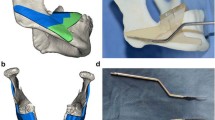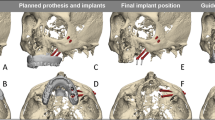Abstract
Purpose
Le Fort-based face–jaw–teeth transplantation (FJTT) attempts to marry bone and teeth geometry of size-mismatched face–jaw–teeth segments to restore function and form due to severe mid-facial trauma. Recent development of a computer-assisted planning and execution (CAPE) system for Le Fort-based FJTT in a pre-clinical swine model offers preoperative planning, and intraoperative navigation. This paper addresses the translation of the CAPE system to human anatomy and presents accuracy results.
Methods
Single-jaw, Le Fort-based FJTTs were performed on plastic models, one swine and one human, and on a human cadaver. Preoperative planning defined the goal placement of the donor’s Le Fort-based FJTT segment on the recipient. Patient-specific navigated cutting guides helped achieve planned osteotomies. Intraoperative cutting guide and donor fragment placement were compared with postoperative computed tomography (CT) data and the preoperative plan.
Results
Intraoperative measurement error with respect to postoperative CT was less than 1.25 mm for both mock transplants and 3.59 mm for the human cadaver scenario. Donor fragment placement (as compared to the planned position) was less accurate for the human model test case (2.91 mm) compared with the swine test (2.25 mm) and human cadaver (2.26 mm).
Conclusion
The results indicate the viability of the CAPE system for assisting with Le Fort-based FJTT and demonstrate the potential in human surgery. This system offers a new path forward to achieving improved outcomes in Le Fort-based FJTT and can be modified to assist with a variety of other surgeries involving the head, neck, face, jaws and teeth.










Similar content being viewed by others
References
Gordon CR, Susarla SM, Peacock ZS, Cetrulo CL, Zins JE, Papay F, Kaban LB (2011) Osteocutaneous maxillofacial allotransplantation: lessons learned from a novel cadaver study applying orthognathic principles and practice. Plast Reconstr Surg 128(5):465e–479e
Siemionow M, Ozturk C (2011) An update on facial transplantation cases performed between 2005 and 2010. Plast Reconstr Surg 128(6):707e–720e
Gordon CR, Susarla SM, Peacock ZS, Kaban LB, Yaremchuk MJ (2012) Le Fort-based maxillofacial transplantation: current state of the art and a refined technique using orthognathic applications. J Craniofac Surg 23(1):81–87
Mohan R, Borsuk DE, Dorafshar AH, Wang HD, Bojovic B, Christy MR, Rodriguez ED (2014) Aesthetic and functional facial transplantation: a classification system and treatment algorithm. Plast Reconstr Surg 133(2):386–397
Siemionow MZ, Papay F, Djohan R, Bernard S, Gordon CR, Alam D, Hendrickson M, Lohman R, Eghtesad B, Fung J (2010) First us near-total human face transplantation: a paradigm shift for massive complex injuries. Plast Reconstr Surg 125(1):111–122
Meningaud J-P, Hivelin M, Benjoar M-D, Toure G, Hermeziu O, Lantieri L (2011) The procurement of allotransplants for ballistic trauma: a preclinical study and a report of two clinical cases. Plast Reconstr Surg 127(5):1892–1900
Gordon CR, Siemionow M, Papay F, Pryor L, Gatherwright J, Kodish E, Paradis C, Coffman K, Mathes D, Schneeberger S et al (2009) The world’s experience with facial transplantation: what have we learned thus far? Ann Plast Surg 63(5):572–578
Dorafshar AH, Bojovic B, Christy MR, Borsuk DE, Iliff NT, Brown EN, Shaffer CK, Kelley TN, Kukuruga DL, Barth RN et al (2013) Total face, double jaw, and tongue transplantation: an evolutionary concept. Plast Reconstr Surg 131(2):241–251
Taylor RH (1996) Computer integrated surgery: technology and clinical applications. The MIT press, Cambridge
Taylor R, Joskowicz L (2003) Computer-integrated surgery and medical robotics. In: Standard handbook of biomedical engineering and design, 2nd edn. McGraw Hill, New York, pp 29–33
Bell RB (2010) Computer planning and intraoperative navigation in cranio-maxillofacial surgery. Oral Maxillofac Surg Clin N Am 22(1):135–156
Bookstein FL, Grayson B, Fellingham L, McCarthy JG et al (1986) Three-dimensional computer-assisted design of craniofacial surgical procedures: optimization and interaction with cephalometric and ct-based models. Plast Reconstr Surg 77(6):877–885
Altobelli DE, Kikinis R, Mulliken JB, Cline H, Lorensen W, Jolesz F et al (1993) Computer-assisted three-dimensional planning in craniofacial surgery. Plast Reconstr Surg 92(4):576–585
Hirsch DL, Garfein ES, Christensen AM, Weimer KA, Saddeh PB, Levine JP (2009) Use of computer-aided design and computer-aided manufacturing to produce orthognathically ideal surgical outcomes: a paradigm shift in head and neck reconstruction. J Oral Maxillofac Surg 67(10):2115–2122
Rudman K, Hoekzema C, Rhee J (2011) Computer-assisted innovations in craniofacial surgery. Faci Plast Surg 27(04):358–365
Sabol JV, Grant GT, Liacouras P, Rouse S (2011) Digital image capture and rapid prototyping of the maxillofacial defect. J Prosthodont 20(4):310–314
Liacouras P, Garnes J, Roman N, Petrich A, Grant GT (2011) Designing and manufacturing an auricular prosthesis using computed tomography, 3-dimensional photographic imaging, and additive manufacturing: A clinical report. J Prosthet Dent 105(2):78–82
van Noort R (2012) The future of dental devices is digital. Dent Mater 28(1):3–12
Gordon CR, Swanson EW, Susarla SM, Coon D, Rada E, Al Rakan M, Shores JT, Bonawitz SC, Fishman EK et al (2013) Overcoming cross-gender differences and challenges in Le Fort-based, craniomaxillofacial transplantation with enhanced computer-assisted technology. Ann Plast Surg 71(4):421–428
Gordon CR, Murphy RJ, Coon D, Basafa E, Otake Y, Al Rakan M, Susarla S, Swanson E, Fishman E et al (2014) Preliminary development of a workstation for craniomaxillofacial surgical procedures: introducing a computer-assisted planning and execution system. J Craniofac Surg 25(1):273–283
Basafa E, Murphy RJ, Gordon CR, Armand M (2014) Modeling the biomechanics of swine mastication—an inverse dynamics approach. J Biomech 47(11):2626–2632
Bojovic B, Dorafshar AH, Brown EN, Christy MR, Borsuk DE, Hui-Chou HG, Shaffer CK, Kelley TN, Sauerborn PJ, Kennedy K Hyder M, Brazio PS, Philosophe B, Barth RN, Scalea TM, Bartlett SD, Rodriguez ED (2012) Total face, double jaw, and tongue transplant research procurement: an educational model. Plast Reconstr Surg 130(4):824–834
Al Rakan M, Shores JT, Bonawitz S, Santiago G, Christensen J, Grant G, Murphy RJ, Basafa E, Armand M, Otovic P et al (2014) Ancillary procedures necessary for translational research in experimental craniomaxillofacial surgery. J Craniofac Surg, (in Press)
Besl PJ, McKay ND (1992) A method for registration of 3-d shapes. IEEE Trans Pattern Anal Mach Intell 14(2):239–256
Santiago GF, Susarla SM, Rakan MA, Coon D, Rada EM, Sarhane K et al (2014) Establishing cephalometric landmarks for the translational study of Le Fort-based facial transplantation in swine: Enhanced applicaitons using computer-assisted surgery and custom cutting guides. Plast Reconstr Surg 135(5):1138–1151
Zins JZ, Gordon CR (2014) Craniofacial applications in facial aesthetic surgery. In: Zins JZ, Gordon CR (eds) Handbook of Craniomaxillofacial Surgery, World Scientific Publishing, Singapore
Taft RM, Kondor S, Grant GT (2011) Accuracy of rapid prototype models for head and neck reconstruction. J Prosthet Dent 106(6):399–408
Horn BKP (1987) Closed-form solution of absolute orientation using unit quaternions. J Opt Soc Am A 4(4):629–642
Connor AM, Moshiri F (1985) Orthognathic surgery norms for American black patients. Am J Orthod 87(2):119–134
Lepistö J, Armand M, Armiger RS (2008) Periacetabular osteotomy in adult hip dysplasia—developing a computer aided real-time biomechanical guiding system (BGS). Suom Ortop Traumatol 31(2):186–190
Sugano N, Sasama T, Sato Y, Nakajima Y, Nishii T, Yonenobu K, Tamura S, Ochi T (2001) Accuracy evaluation of surface-based registration methods in a computer navigation system for hip surgery performed through a posterolateral approach. Comput Aided Surg 6(4):195–203
Dorafshar AH, Brazio PS, Mundinger GS, Mohan R, Brown EN, Rodriguez ED (2014) Found in space: computer-assisted orthognathic alignment of a total face allograft in six degrees of freedom. J Oral Maxillofac Surg 72(9):1788–1800
Acknowledgments
The authors gratefully thank Dr. Kevin Wolfe for his expertise and design of the new reference fixation on the human skull. Funding was provided by the 2011 Basic Science Research grant from American Society of Maxillofacial Surgeons, 2012–2014 Academic Scholar Award from American Association of Plastic Surgeons, the Accelerated Translational Incubator Program Award at Johns Hopkins University’s Institute for Clinical and Translational Research (funded by National Institutes of Health), Independent Research and Development funds from the Johns Hopkins Applied Physics Laboratory, and the Abell Foundation Award/Johns Hopkins Alliance for Science and Technology development. This study was made possible, in part, by the Johns Hopkins Institute for Clinical and Translational Research (ICTR) which is funded in part by the National Center for Advancing Translational Sciences (NCATS), a component of the National Institutes of Health (NIH), and NIH Roadmap for Medical Research. Its contents are solely the responsibility of the authors and do not necessarily represent the official view of the Johns Hopkins ICTR, NCATS or NIH (NCATS Grant # UL1TR000424-06).
Conflict of interest
The authors declare that they have no conflict of interest.
Ethical standard The manuscript does not contain clinical studies or patient data and an approval by an ethics committee was not applicable. All human cadaver specimens were donated and prepared in accordance with the bylaws presented by the Maryland State Anatomy Board.
Author information
Authors and Affiliations
Corresponding author
Additional information
The views expressed in this article are those of the authors and do not necessarily reflect the official policy, position, or endorsement of the Department of the Navy, Army, Department of Defense, nor the U.S. Government.
Rights and permissions
About this article
Cite this article
Murphy, R.J., Gordon, C.R., Basafa, E. et al. Computer-assisted, Le Fort-based, face–jaw–teeth transplantation: a pilot study on system feasiblity and translational assessment. Int J CARS 10, 1117–1126 (2015). https://doi.org/10.1007/s11548-014-1114-9
Received:
Accepted:
Published:
Issue Date:
DOI: https://doi.org/10.1007/s11548-014-1114-9




